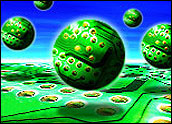
University of Delaware’s Dr. Ian Appelbaum is looking to “spin” hisresearch on the magnetic properties of electrons to get moreelectronic enhancements from semiconductors.
Appelbaum’s research is now funded in part with a nearly half-million dollar grantfrom the U.S. Department of Defense Experimental Program to StimulateCompetitive Research (DEPSCoR). Since the Fall of 2004, he has headeda research team at the University of Delaware.
As an MIT graduate student, the spintronics physicist conceived,developed, and experimentally demonstrated a mechanism for hotelectron injection luminescence in scanning probe microscopy onburied-heterostructure light-emitting devices. He applied thisluminescence mechanism to hot-electron-mediated direct opticalup-conversion. He also developed computational schemes to model hotelectron transport in nanoscale semiconductor heterostructures viaballistic electron emission spectroscopy.
The purpose of it all: making better semiconductor devices. The developments could one day result in new hardware found in things like computer hard drives.
These early accomplishments led to further recognition for his effortsas semiconductor specialist working to gain benefits from spincharacteristics of electrons, or spintronics. He earned his doctoraldegree in physics at the Massachusetts Institute of Technology (MIT)in June 2003. After one year as a postdoctoral fellow at HarvardUniversity, Appelbaum became an assistant professor of electricalengineering at the University of Delaware in the fall of 2004.
Appelbaum’s research group developed innovative hot electrontechniques for both injection and detection of spins insemiconductors. Also, his research group was the first to overcomesignificant electronic structure and materials challenges todemonstrate spin transport in silicon.
Starting with the spring semester of 2009, Appelbaum will move hisresearch team to the University of Maryland, where he will be atenured associate professor of physics.
Pursuing DEPSCoR
Universities and colleges in certain states apply annually for specialfunding consideration in research projects that may benefit U.S.national defense. Known as “The Department of Defense ExperimentalProgram to Stimulate Competitive Research (DEPSCoR) Program,” theapplication process involves a yearly peer review competition forfunds.
Besides meeting Department of Defense (DoD) goals, the programsupports EPSCoR member states’ efforts for stimulating competitiveresearch capabilities. In fiscal year 2007, the DoD awarded US$9 million to 14 academic institutions in nine states toperform research in science and engineering fields important tonational defense.
“Historically, about half the 50 states get less money for research. Other than being an EPSCOR state, the awards are based onresearch merit,” Appelbaum told TechNewsWorld in explaining hisinvolvement with the grant award. “The grant pays for research expenses such as supplies and equipment, and for expenses associated with hiring graduate students.”
The DEPSCoR program is sponsored by the Office of the Deputy UnderSecretary of Defense for Laboratories and Basic Sciences. It is administered by the Army Research Office (ARO), theOffice of Naval Research (ONR) and the Air Force Office of ScientificResearch (AFOSR) in cooperation with the state EPSCoR offices.
Appelbaum’s Lab
TechNewsWorld spoke with Appelbaum recently to discuss his research ashe prepared to move his lab.
TechNewsWorld: In layman’s terms, what is spintronics?
Appelbaum:
“Spintronics” means spin transport electronics, where “spin” is the intrinsic angular momentum of electrons. This angular momentum is coupled to a magnetic moment, so each electron behaves like a quantum magnet where the north-south magnetic orientation can be “up” or “down.”In non-magnetic semiconductors, there are just as many up- as down-oriented electron spins, so the effects of spin are averaged out. Creating an imbalance of one spin orientation over the other provides new ways to operate devices, or improved performance.[*See editor’s note]
TNW: Obviously semiconductors have been a vital part of computertechnology in particular and electronics in general for some time.What are you looking for?
Appelbaum:
One key property of an electron charge is what iscalled its “magnetic moment.” We’ve known about these properties for avery long time. We continue to look for breakthroughs in what is nowcalled “spin technology.”
TNW: How evident is this electron spin to researchers?
Appelbaum:
Many phenomena show the effects of spin, especially optical effects such as changes in the polarization of light emitted by semiconductors in a magnetic field.
TNW: Is spin technology a relatively new field of study?
Appelbaum:
My research grew out of work done in the 1980s and1990s with semiconductor materials.
TNW: Since your grant award is connected to a DoD interest, you mustbe pursuing spintronics for more than the benefits of pure research.What are you trying to accomplish?
Appelbaum:
Manipulation of electron spins in semiconductors could potentially lead to new ways of processing information encoded in the spin orientation — up and down may replace 1 and 0. This paradigm may also have the potential to operate at lower power than present-day technology.
TNW: How is this related to your research?
Appelbaum:
We are developing silicon-based transistors utilizing spin-polarized electron transport to control the output characteristics. Silicon has several intrinsic qualities that make it the ideal semiconductor for spintronics.
TNW: How might this advance the field of electronics?
Appelbaum:
Spintronics has not yet been useful ininformation-processing circuits. To enable spin-based integratedcircuits, long spin lifetimes are needed. Silicon has been broadlyviewed as the ideal material for spintronics due to its properties.
TNW: Has your research produced any solutions?
Appelbaum:
Over the last two years we have shown how to applycertain methods [of achieving coherent spin transport in silicon] thatare not hinging on silicon’s properties. These methods involve usingunique spin-polarized hot-electron injection and detection techniques.
TNW: How soon before you will see applications for consumer products?
Appelbaum:
In terms of those results, it is way off in the future.We are nowhere near consumer applications. Right now we are doing purescience, but we also want to keep an eye on doing something useful.
TNW: Is your research isolated from other study of spintronics, or areyou working with other teams of researchers in sharing results?
Appelbaum:
I see others getting involved in this research, especially theorists who can help us understandthe subtle new concepts governing spins in semiconductors.
*ECT News Network editor’s note: Our original version of this article contained misrepresentations of Ian Appelbaum’s responses to the interview questions. This revised interview is based on clarifications Appelbaum provided to ECT News Network after the original piece was published.




















































